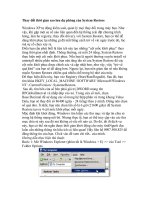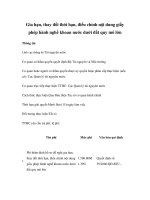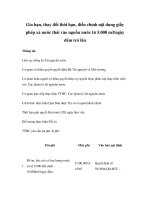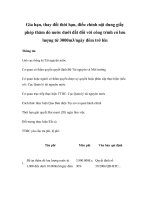james clear - transform your habits- v3 - THAY ĐỔI THÓI QUEN
Bạn đang xem bản rút gọn của tài liệu. Xem và tải ngay bản đầy đủ của tài liệu tại đây (736.32 KB, 49 trang )
TRANSFORM YOUR HABITS
3rd Edition
Note from James Clear:
I wrote Transform Your Habits to create a free guide that would help people like
you make progress in health, business, and life. You are welcome to share it with
anyone you think it would benefit. The latest version of Transform Your Habits can
always be downloaded at
jamesclear.com/habits
For more ideas on how to master your habits, improve your performance, and
boost your mental and physical health, you can visit JamesClear.com or join my
free newsletter at
jamesclear.com/newsletter
As always, thanks for reading.
-James
JamesClear.com
Page 1
10 Things This Guide Will Teach You
1. How to reverse your bad habits and stick to good ones.
2. The science of how your brain processes habits.
3. The common mistakes most people make (and how to avoid them).
4. How to overcome a lack of motivation and willpower.
5. How to develop a stronger identity and believe in yourself.
6. How to make time for new habits (even when your life gets crazy).
7. How to design your environment to make success easier.
8. How to make big changes in your life without overwhelming yourself.
9. How to get back on track when you get off course with your goals.
10. And most importantly, how to put these ideas into practice in real life.
JamesClear.com
Page 2
Table of Contents
Why Is It so Hard to Stick to Good Habits?
4
The Common Mistake You Want to Avoid
5
The Science of How Your Habits Work
8
Identity-Based Habits: How to Actually Stick to Your Goals
17
The Best Way to Start a New Habit
21
How to Fit New Habits into Your Life
24
How to Make Big Changes Without Overwhelming Yourself
29
How to Get Back on Track After Slipping up
34
How to Break a Bad Habit (and Replace It With a Good One)
37
How to Slowly Eliminate Bad Habits
43
The Next Step: Where to Go From Here
46
JamesClear.com
Page 3
Why Is It So Hard to Stick to Good
Habits?
It seems to be remarkably easy to fall into unhealthy routines.
★ Eating junk food.
★ Watching TV instead of going to the gym.
★ Showing up to a job you hate everyday.
★ Biting your nails.
★ Smoking.
There’s no shortage of unhealthy and unproductive behaviors. And we all struggle
with them from time to time.
But why? You want to live a healthy, fulfilling, and remarkable life. And every now
and then you probably get really motivated and inspired to make a change. So how
come it is more likely that this time next year you'll be doing the same thing rather
than something better? Why is it so hard to stick to good habits?
I believe that it is because we usually try to make changes in the wrong way. And in
this guide, I'm going to share a blend of science and real-world experiences that
share a better strategy for making long-term changes in your life.
Let's get started.
JamesClear.com
Page 4
The Common Mistake You Want to
Avoid
“Your audacious life goals are fabulous. We’re proud of you for having them. But it’s
possible that those goals are designed to distract you from the thing that’s really
frightening you—the shift in daily habits that would mean a re–invention of how you see
yourself.”
—Seth Godin
Transformations and overnight successes get a lot of hype. (For good reason, who
wouldn't want to be more successful in less time?)
But here's the problem: when you hear about a dramatic transformation (like
someone losing 100 pounds) or a incredible success story (like someone building a
million dollar business in 1 year), the only thing you know is the event that people
are talking about. You don't hear anything about the process that came before it or
about the habits that led to the eventual result.
It's easy to let these incredible stories trick you into doing too much, too soon. I
know I've done it. When you get motivated and inspired to take your life to the
next level, it's so easy to get obsessed with the result. I need to lose 20 pounds (or
40 or 60 or 100). I need to squat 300 pounds (or 400 or 500). I need to meditate 3
days per week (or 5 or 7).
Or thousands of other variations of your life goals.
JamesClear.com
Page 5
It's natural to think that we need the result, the transformation, the overnight
success. But that's not what you need. You need better habits.
It’s so easy to overestimate the importance of one defining moment and
underestimate the value of making better decisions on a daily basis.
Almost every habit that you have — good or bad — is the result of many small
decisions over time. And if this is true, if the problems you’re facing now are the
result of thousands of small decisions made over the course of years, then
wouldn’t it make sense that path to success, health, strength, joy, fulfillment,
meaning, and vitality would also be through thousands of daily decisions?
And yet, how easily we forget this when we want to make a change.
When you become obsessed with achieving a result quickly, the only thing you
think about is how to get to your goal, and you forget to realize that our process for
achieving goals is just as important as whether or not you achieve them at all. The
desire to achieve results quickly fools you into thinking that the result is the prize.
But here's the truth…
Becoming the type of person you want to become — someone who lives by a
stronger standard, someone who believes in themselves, someone who can be
counted on by the people that matter to them — is about the daily process you
follow and not the ultimate product you achieve.
Why is this true? Because your life today is essentially the sum of your habits.
How in shape or out of shape you are? A result of your habits.
How happy or unhappy you are? A result of your habits.
How successful or unsuccessful you are? A result of your habits.
JamesClear.com
Page 6
What you repeatedly do (i.e. what you spend time thinking about and doing each
day) ultimately forms the person you are, the things you believe, and the
personality that you portray.
The most common mistake that people make is setting their sights on an event, a
transformation, an overnight success they want to achieve – rather than focusing
on their habits and routines.
I've been guilty of this just like everyone else. And even today, I'm still learning
how to master my habits just like you.
But over time, I've discovered a helpful blend of academic research and real world
experiences that have allowed me to make progress in many areas of life. In this
guide, I want to share that progress with you so that you can avoid chasing another
overnight success and actually stick to your goals for the long-term.
Let's get started by talking about the science of sticking to good habits.
JamesClear.com
Page 7
The Science of How Your Habits
Work (The 3 R's of Habit Change)
There is a simple 3–step pattern that every habit follows. I call this pattern the “3
R's of Habit Change” and it goes like this...
1. Reminder (the trigger that initiates the behavior)
2. Routine (the behavior itself; the action you take)
3. Reward (the benefit you gain from doing the behavior)
This sequence has been proven over and over again by behavioral psychology
researchers. I originally learned of this cycle from Stanford professor, BJ Fogg. And
more recently, I read about it in Charles Duhigg’s best–selling book, The Power of
Habit.
(Duhigg’s book refers to the three steps as cue, routine, reward. Regardless of how
it's phrased, the point is that there is a lot of science behind the process of habit
formation, and so we can be relatively confident that your habits follow the same
cycle.)
Let me show you what the 3 R's look like in real life by applying the framework to a
typical habit. (In this case, answering a phone call.)
Step One:
Your phone rings (reminder). This is the reminder that initiates the
behavior. The ring acts as a trigger or cue to tell you to answer the phone. It is the
prompt that starts the behavior.
JamesClear.com
Page 8
Step Two:
You answer your phone (routine). This is the actual behavior. When your
phone rings, you have a habit of answering it.
Step Three:
You find out who is calling (reward). The reward is the benefit gained
from doing the behavior. In this case, the reward for completing the habit was
satisfying your curiosity to find out why the other person was calling you.
Result:
If the reward is positive, then the cycle forms a positive feedback loop that
tells your brain, “Next time this reminder happens, do the same thing.” (i.e. When
the phone rings again, answer it.)
Follow this same cycle enough times and you'll stop thinking about it. Your
behavior will just become a habit.
All habits form by the same 3–step process. (Graphic based on Charles Duhigg’s “Habit
Loop” in The Power of Habit. Created by James Clear.)
How can you use this structure to create new habits and actually stick to them?
JamesClear.com
Page 9
Here’s how…
Step 1: Use a Current Habit as the Reminder for
Your New One
If you talk to your friends about starting a new habit, they might tell you that you
need to exercise self–control or that you need to find a new dose of willpower.
I disagree.
Getting motivated and trying to remember to do a new behavior is the exact wrong
way to go about it. If you think about this, it makes sense. Sometimes you feel
motivated and sometimes you don't, right? So why would you want to rely on
motivation (something that changes) to create a new habit (something that you
want to be consistent)?
This is why the reminder – the trigger for your new behavior – is such a critical part
of forming new habits. A good reminder makes it easier for you to start your habit
by encoding your new behavior in something that you already do, rather than
relying on getting motivated.
For example, I created a new habit of flossing each day by always doing it after
brushing my teeth. The act of brushing my teeth was something that I already did
and it acted as the trigger or cue to do my new behavior.
To make things even easier and prevent myself from having to remember to floss, I
bought a bowl, placed it next to my toothbrush, and put a handful of pre–made
flossers in it. Now I see the floss every time I reach for my toothbrush.
JamesClear.com
Page 10
Setting up a visible reminder and linking my new habit with a current behavior
made it much easier to change. No need to be motivated. No need to remember.
How to Choose Your Reminder
It doesn’t matter if it’s working out or eating healthy or creating art, you can’t
expect yourself to magically stick to a new habit without setting up a system that
makes it easier to start. And for that reason, picking the correct reminder for your
new habit is the first step to making change easier.
The reminder that you choose to initiate your new behavior is specific to your life
and the habit that you're trying to create.
The best way I know to discover a good reminder for your new habit is to write
down two lists. In the first list, write down the things that you do each day without
fail.
For example…
★ Get in the shower.
★ Put your shoes on.
★ Brush your teeth.
★ Flush the toilet.
★ Sit down for dinner.
★ Turn the lights off.
★ Get into bed.
You’ll often find that many of these items are daily health habits like washing your
face, drinking morning tea, brushing your teeth, and so on. Those actions can act
as reminders for new health habits. For example, “
After I drink my
morning tea, I
meditate for 60 seconds.
”
JamesClear.com
Page 11
In the second list, write down the things that happen to you each day...
★ You stop at a red light.
★ You get a text message.
★ A commercial comes on TV.
★ A song ends.
★ The sun sets.
These events can also act as triggers for your new habit. For example, if you wanted
to “
When a commercial comes on TV, I do five pushups.
”
With these two lists, you’ll have a wide range of things that you already do and
already respond to each day. Those are the perfect reminders for new habits.
For example, let’s say you want to feel happier. Expressing gratitude is one proven
way to boost happiness. Using the list above, you could pick the reminder “sit
down for dinner” and use it as a cue to say one thing that you’re grateful for today.
“
When I sit down for dinner, I say one thing that I’m grateful for today.
”
That’s the type of small behavior that could blossom into a more grateful outlook
on life in general.
Step 2: Make Your Habits Incredibly Easy to Start
Make it so easy you can’t say no.
—Leo Babauta
As I mentioned in the beginning of this guide, it’s incredibly easy to get caught up
in the desire to make massive changes in your life. We watch incredible weight loss
JamesClear.com
Page 12
transformations and think that we need to lose 30 pounds in the next 4 weeks. We
see elite athletes on TV and wish that we could run faster and jump higher
tomorrow. We want to earn more, do more, and be more … right now.
I’ve felt those things too, so I get it. And in general, I applaud the enthusiasm. I’m
glad that you want great things for your life and I want to do what I can to help you
achieve them. But it’s important to remember that lasting change is a product of
daily habits, not once-in-a-lifetime transformations.
If you want to start a new habit and begin living healthier and happier, then I have
one suggestion that I cannot emphasis enough: start small. In the words of Leo
Babauta, “make it so easy that you can’t say no.”
How small? Stanford professor BJ Fogg suggests that people who want to start
flossing begin by flossing only one tooth. Just one.
In the beginning, performance doesn’t matter. What does matter is becoming the
type of person who always sticks to your new habit – no matter how small or
insignificant it seems. You can build up to the level of performance that you want
once the behavior becomes consistent.
Your homework:
Pick a new habit you want to start. Now ask yourself, “How can I
make this new behavior so easy to do that I can’t say no?”
Step 3: Always Reward Yourself
It’s important to celebrate. (I think that’s just as true in life as it is with habits.)
When it comes to sticking to better habits, there is an important reason to always
reward yourself: we want to continue doing things that make us feel good.
JamesClear.com
Page 13
And that is why it’s especially important that you reward yourself each time you
practice your new habit.
For example, if I’m working towards a new fitness goal, then I’ll often tell myself
at the end of a workout, “That was good day.” Or, “Good job. You made progress
today.”
If you feel like it, you could even tell yourself “Victory!” or “Success!” each time
you do your new habit.
I haven’t done this myself, but some people swear by it.
★ Floss one tooth. “Victory!”
★ Eat a healthy meal. “Success!”
★ Do five pushups. “Good work!”
Rewarding yourself with positive self–talk can take some getting used to if you’re
not someone who typically does that. But even if it sounds silly, research has
proven that the reward is an important part of the habit process. Give yourself
some credit and enjoy each small success.
Related note: Make sure that the habits you are trying to build are actually important to
you. It’s tough to find a reward in something when you’re only doing it because you think
other people expect it or would approve of it. It's your life, so make sure you're spending
your time on things that are important to you.
Now that we've covered the science of habit formation, let's talk about how to use
it in real life.
JamesClear.com
Page 14
Identity-Based Habits: How to
Actually Stick to Your Goals For the
Long-Term
We've covered the science of habit formation. But in the real world, there is often a
difference between theory and practice.
Whenever I write, I do my best to not merely share ideas backed by science, but
also to highlight real-world lessons that make it easier for you to put those ideas
into practice.
This is especially important when it comes to building better habits. We all want to
become better people — stronger and healthier, more creative and more skilled, a
JamesClear.com
Page 15
better friend or family member. But even if we get really inspired and start doing
things better, it’s tough to actually stick to new behaviors. It’s more likely that this
time next year you’ll be doing the same thing than performing a new habit with
ease.
Luckily, you can use a strategy that I call “identity-based habits” to make change
easier and stick to your goals over the long-term.
Here's how it works...
What Remembering Names Can Teach You About
Habits
My girlfriend is great at remembering people’s names.
Recently, she told me a story that happened when she was in high school. She went
to a large high school and it was the first day of class. Many of the students had
never met before that day. The teacher went around the room and asked each
person to introduce themselves. At the end, the teacher asked if anyone could
remember everyone’s name.
My girlfriend raised her hand and proceeded to go around the room and accurately
name all 30 or so people. The rest of the room was stunned. The guy next to her
looked over and said, “I couldn’t even remember your name.”
She said that moment was an affirming experience for her. After that happened
she felt like, “I’m the type of person who is good at remembering people’s
names.”
Even today, she is great at remembering the names of anyone we come across.
JamesClear.com
Page 16
Here’s what I learned from that story: In order to believe in a new identity, we have
to prove it to ourselves.
Identity-Based Habits: How to Build Lasting
Habits
The key to building lasting habits is focusing on creating a new identity first. Your
current behaviors are simply a reflection of your current identity. What you do now
is a mirror image of the type of person you believe that you are (either consciously
or subconsciously).
To change your behavior for good, you need to start believing new things about
yourself.
Imagine how we typically set goals. We might start by saying “I want to lose
weight” or “I want to get stronger.” If you’re lucky, someone might say, “That’s
great, but you should be more specific.”
So then you say, “I want to lose 20 pounds” or “I want to squat 300 pounds.”
These goals are centered around our performance or our appearance.
Performance and appearance goals are great, but they aren’t the same as habits. If
you’re already doing a behavior, then these types of goals can help drive you
forward.
But if you’re trying to start a new behavior, then I think it would be far
better to start with an identity–based goal.
JamesClear.com
Page 17
The image below shows the difference between identity–based goals and
performance and appearance–based goals.
Graphic by James Clear.
The interior of behavior change and building better habits is your identity. Each
action you perform is driven by the fundamental belief that it is possible. So if you
change your identity (the type of person that you believe that you are), then it’s
easier to change your actions.
The reason why it’s so hard to stick to new habits is that we often try to achieve a
performance or appearance–based goal without changing our identity. Most of the
time we try to achieve results before proving to ourselves that we have the identity
of the type of person we want to become.
It should be the other way around.
JamesClear.com
Page 18
The Recipe for Sustained Success
Changing your beliefs isn’t nearly as hard as you might think. There are two steps.
1. Decide the type of person you want to be.
2. Prove it to yourself with small wins.
Note:
I cannot emphasize enough how important it is to start with incredibly small
steps. The goal is not to achieve results at first, the goal is to become the type of
person who can achieve those things.
For example, a person who works out consistently is the type of person who can
become strong. Develop the identity of someone who works out first, and then
move on to performance and appearance later. Start small and trust that the
results will come as you develop a new identity.
On the next page, you'll find five examples of how you can use identity-based
habits in real life.
Example 1: Want to lose weight?
Identity: Become the type of person who moves more every day.
Small win: Buy a pedometer. Walk 50 steps when you get home from work.
Tomorrow, walk 100 steps. The day after that, 150 steps. If you do this 5 days per
week and add 50 steps each day, then by the end of the year, you’ll be walking over
10,000 steps per day.
Example 2: Want to become a better writer?
JamesClear.com
Page 19
Identity: Become the type of person who writes 1,000 words every day.
Small win: Write one paragraph each day this week.
Example 3: Want to become strong?
Identity: Become the type of person who never misses a workout.
Small win: Do pushups every Monday, Wednesday, and Friday.
Example 4: Want to be a better friend?
Identity: Become the type of person who always stays in touch.
Small win: Call one friend every Saturday. If you repeat the same people every 3
months, you’ll stay close with 12 old friends throughout the year.
Example 5: Want to be taken seriously at work?
Identity: become the type of person who is always on time.
Small win: Schedule meetings with an additional 15–minute gap between them so
that you can go from meeting to meeting and always show up early.
What is Your Identity?
In my experience, when you want to become better at something, proving your
identity to yourself is far more important than getting amazing results. This is
especially true at first.
JamesClear.com
Page 20
If you want to get motivated and inspired, then feel free to watch a YouTube video,
listen to your favorite song, or try P90X. But don’t be surprised if you burn out after
a week. You can’t rely on being motivated to make lasting changes in your life. You
have to become the type of person you want to be, and that starts with proving
your new identity to yourself.
If you’re looking to make a change, then I say stop worrying about results and start
worrying about your identity. Become the type of person who can achieve the
things you want to achieve. Build the habit now. The results can come later.
Combining Strategies for Maximum Success
Identity-based habits offer a framework through which to view your goals. The 3
R's of habit change provide a plan for achieving your new identity. Combining both
of these ideas can make change easier for you overall.
In other words, identity-based habits keep you focused on the right things: like
starting small, building your identity, and not worrying about results. Meanwhile,
the 3 R's of habit change make sure that you do things in the right way: like linking
your new habit to a current behavior and rewarding yourself for a job well done.
JamesClear.com
Page 21
The Best Way to Start Your New Habit
If you’re serious about doing things better than you are now – in other words, if
you're serious about sticking to good habits – then you have to start small.
Imagine the typical habits, good or bad: Brushing your teeth. Putting your seatbelt
on. Biting your nails.
These actions are small enough that you don’t even think about them. You simply
do them automatically. They are tiny actions that become consistent patterns.
Wouldn’t it make sense that if we wanted to form new habits, the best way to start
would be to make tiny changes that our brain could quickly learn and automatically
repeat?
What if you started thinking of your life goals, not as big, audacious things that you
can only achieve when the time is right or when you have better resources or when
you finally catch your big break … but instead as tiny, daily behaviors that are
repeated until success becomes inevitable?
What if losing 50 pounds wasn’t dependent on a researcher discovering the perfect
diet or you finding a superhuman dose of willpower, but hinged on a series of tiny
habits that you could always control? Habits like walking for 20 minutes per day,
drinking 8 glasses of water per day, eating two meals instead of three.
Too often we get obsessed with making life–changing transformations. I believe
you would make more progress by focusing on lifestyle behaviors.
JamesClear.com
Page 22
★ Losing 50 pounds would be life–changing, drinking 8 glasses of water per
day is a new type of lifestyle.
★ Publishing your first book would be life–changing, emailing a new book
agent each day is a new type of lifestyle.
★ Running a marathon would be life–changing, running 3 days per week is a
new type of lifestyle.
★ Earning an extra $20,000 each year would be life–changing, working an
extra 5 hours per week as a freelancer is a new type of lifestyle.
★ Squatting 100 more pounds would be life–changing, squatting 3 days per
week is a new type of lifestyle.
Do you see the difference?
I think the following quote from BJ Fogg, a professor at Stanford University, sums
this idea up nicely.
If you plant the right seed in the right spot, it will grow without further coaxing. I
believe this is the best metaphor for creating habits.
The “right seed” is the tiny behavior that you choose. The “right spot” is the
sequencing — what it comes after. The “coaxing” part is amping up motivation,
which I think has nothing to do with creating habits. In fact, focusing on motivation
as the key to habits is exactly wrong.
Let me be more explicit: If you pick the right small behavior and sequence it right,
then you won’t have to motivate yourself to have it grow. It will just happen
naturally, like a good seed planted in a good spot.
—BJ Fogg
How great is that?
JamesClear.com
Page 23
The typical approach is to dive into the deep end as soon as you get a dose of
motivation, only to fail quickly and wish you had more willpower as your new habit
drowns. The new approach is to wade into the shallow water, slowly going deeper
until you reach the point where you can swim whether you’re motivated or not.
Daily habits — tiny routines that are repeatable — are what make big dreams a
reality. Dream big, but start small.
JamesClear.com
Page 24









